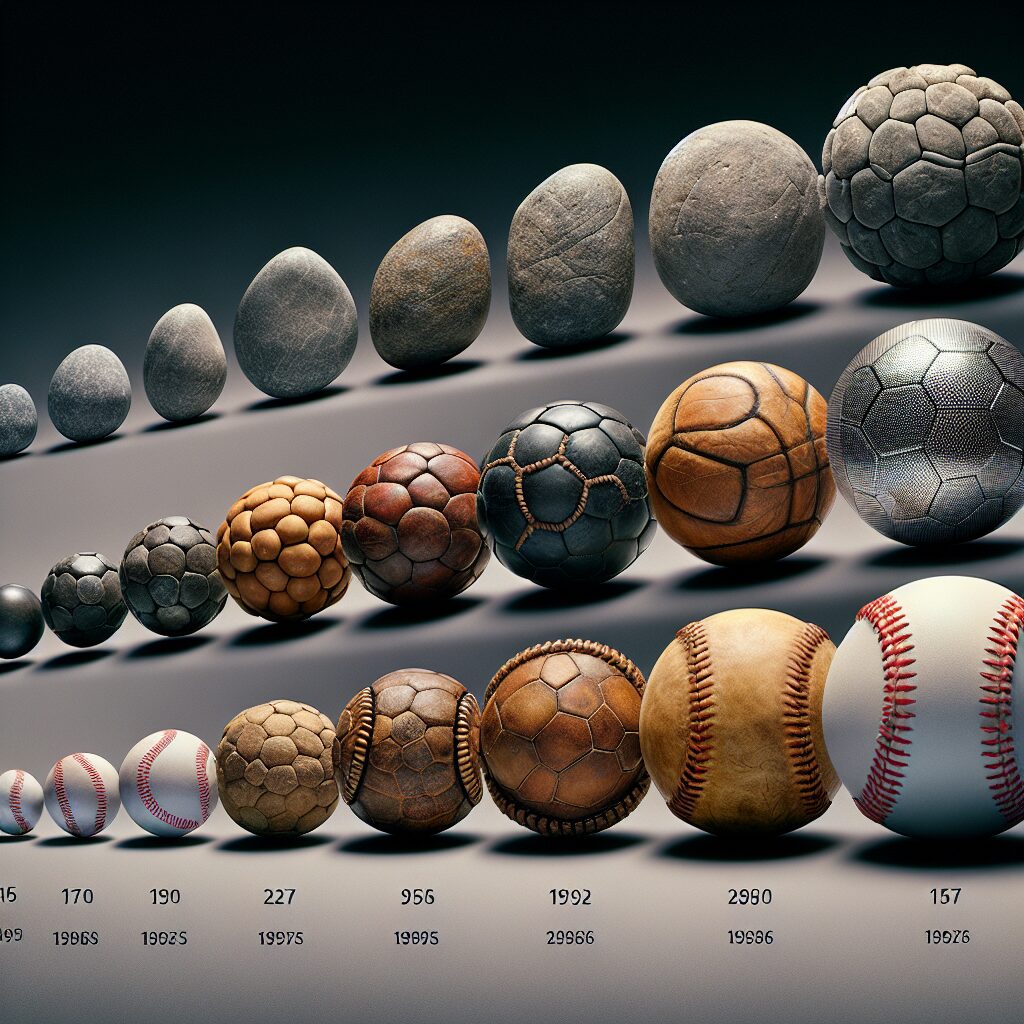Evolution of Ball Sizes: From Past to Present
Did you know that the size of sports balls has not always been the same as it is today? Throughout the history of sports, ball sizes have undergone significant changes, evolving to meet the needs and demands of each game. From ancient times to modern-day sports, the evolution of ball sizes has had a profound impact on the way games are played and enjoyed.
Take the sport of soccer, for example. It may surprise you to learn that in the early days of the game, there were no standardized sizes for soccer balls. Each team would bring their own ball, and the sizes would vary greatly. It wasn’t until the 19th century that the first set of rules regarding the size of soccer balls was introduced. This standardization allowed for a fair and consistent gameplay experience, ensuring that teams competed on an equal level.
Moving on to another popular sport, tennis, we see a similar evolution in ball sizes. In the early days of the game, tennis balls were handmade and filled with various materials, such as hair, feathers, or even cork. These early tennis balls were significantly larger and softer compared to the ones used in the present-day game. It wasn’t until the late 19th century that the size and weight of tennis balls were standardized, allowing for a more predictable and consistent play on the court.
Now that we have explored the fascinating evolution of ball sizes in different sports, let’s delve into the key takeaways from this history. We will discuss how the standardization of ball sizes has influenced the gameplay, strategies, and overall enjoyment of sports. Additionally, we will explore the unique features and impacts of various ball sizes in specific sports, providing insights into how these changes have shaped the sports we know and love today. So, read on to discover the intriguing journey of ball sizes in sports and gain a deeper appreciation for the evolution of the games we play.
Key Takeaways
1. Ball sizes in sports have evolved over time, with various factors such as changes in technology, rules, and player preferences influencing this evolution.
2. The size of balls used in sports like soccer, basketball, and volleyball has generally increased over the years to enhance performance, improve accuracy, and allow for fairer play.
3. The evolution of ball sizes has also been affected by the need to adapt to different playing conditions and environments, such as specific court dimensions or weather conditions.
4. While changes in ball sizes have been met with some resistance and controversy, they have often been driven by the desire to improve the overall quality and fairness of the game.
5. The future of ball sizes in sports remains uncertain but is likely to continue evolving, with advancements in technology and further research shaping the way balls are designed and utilized in various sporting disciplines.
What is the Evolution of Ball Sizes: From Past to Present?
The Origins of Ball Sizes
Throughout history, different sports and games have utilized a variety of ball sizes. The evolution of ball sizes can be traced back to ancient civilizations where early forms of sports were played. These primitive games often involved using natural materials such as animal bladders or rocks to create makeshift balls with varying sizes. The initial ball sizes were determined by the availability of materials and the needs of the specific sport.
Influence of Culture and Time Periods
As societies developed and sports became more organized, ball sizes started to become standardized. Cultural factors and time periods played a significant role in shaping the evolution of ball sizes. For example, during the Renaissance era, ball games like tennis and football gained popularity, and distinct ball sizes were established for each sport. Similarly, in countries like America where baseball became a national pastime, regulations for ball sizes were implemented to ensure fair gameplay.
Technological Advancements
With the advent of technology, innovative materials and manufacturing processes have further impacted the evolution of ball sizes. The introduction of rubber and synthetic materials allowed for more precise control over ball sizes, leading to increased consistency in gameplay. Sports like basketball and volleyball underwent size revisions to enhance gameplay and improve player performance.
Standardization and Modern Trends
In modern times, standardization bodies and sports associations play a crucial role in determining ball sizes to maintain fairness and uniformity across different levels of play. These organizations conduct extensive research and consider various factors such as player safety, skill level, and game dynamics to establish standardized ball sizes. As sports continue to evolve, the evolution of ball sizes is an ongoing process, with potential adjustments being made to accommodate changing game styles and player preferences.
5 Tips for Understanding the Evolution of Ball Sizes
- Research the historical origins of specific sports to understand how ball sizes were determined in the past.
- Consider the cultural and time period influences on ball sizes to gain a broader perspective on the evolution.
- Explore the technological advancements that have allowed for more precise control and standardization of ball sizes.
- Stay updated with the latest regulations and recommendations from sports associations to understand the current standards for ball sizes.
- Observe the ongoing developments in sports to anticipate potential changes in ball sizes and their impact on gameplay.
Frequently Asked Questions
1. How have ball sizes evolved over time?
The evolution of ball sizes in various sports has been influenced by several factors, including changes in game rules, technological advancements, and player preferences. For example, in soccer, the ball size has gradually increased to enhance visibility and maintain fairness in the game.
2. What are some examples of ball size changes?
In tennis, the standard ball size has evolved from 2.5 inches in diameter to the current 2.7 inches, allowing for better playability. Similarly, basketballs have gone through size variations to improve grip and shooting accuracy, while baseballs have undergone modifications to optimize pitching and hitting performance.
3. Why do ball sizes differ in different sports?
Ball sizes vary between sports because each game requires specific characteristics for optimal play. Factors such as contact surface, game pace, skill requirements, and safety considerations contribute to the design and size selection of balls. Consequently, variations in ball sizes cater to the demands and objectives of each sport.
4. Have ball sizes changed significantly in recent years?
While some sports have experienced minor adjustments in ball sizes to enhance gameplay, significant changes in ball sizes are relatively uncommon. Manufacturers and sports associations typically aim to maintain consistency and continuity, considering the familiarity and muscle memory of players accustomed to specific ball sizes.
5. How do ball sizes impact player performance?
The right ball size plays a crucial role in player performance. It affects factors such as ball control, accuracy, feel, grip, and overall game dynamics, influencing passing, shooting, catching, and other essential skills. Choosing the appropriate ball size is essential to facilitate optimal performance and create a fair playing field.
6. Are there any safety considerations related to ball sizes?
Yes, safety is an important aspect when determining ball sizes. For instance, in sports like golf or cricket, smaller ball sizes may reduce the risk of injury when hit by the ball. Likewise, larger-sized balls in sports like rugby or Australian rules football aim to minimize potential harm while maintaining game playability.
7. How do advancements in ball technology impact size evolution?
Advancements in ball technology can contribute to the evolution of ball sizes. Improved materials, manufacturing techniques, and aerodynamics can influence the design and dimensions of balls, leading to optimized performance and enhanced player experiences. Technological advancements often accompany shifts in ball sizes to ensure compatibility and benefits.
8. Are there any psychological factors related to ball sizes?
Absolutely. Ball size can have psychological effects on players, affecting their confidence, comfort level, and perceived control. Subtle changes in ball sizes may generate mental adjustments, requiring players to adapt their playing styles and strategies accordingly.
9. Do ball sizes differ between amateur and professional levels?
While there can be some variations across different levels, most sports strive for consistency in ball sizes across amateur and professional play. This consistency ensures a smooth transition for players as they progress in their respective sports, allowing them to adapt and compete at higher levels without significant adjustments.
10. How can I select the right ball size for my chosen sport?
Choosing the correct ball size for your sport is crucial. You can usually find guidelines provided by sports associations or manufacturers regarding the appropriate ball sizes for various age groups and skill levels. Consulting these guidelines or seeking advice from experienced coaches or players can help you select the optimal ball size to enhance your performance.
Final Thoughts
The evolution of ball sizes reflects the ongoing quest for improvement and innovation in sports. Balancing tradition with technological advancements, ball sizes are constantly assessed to optimize player performance and maintain fairness within each game. Understanding the historical context and rationale behind ball size changes allows athletes, coaches, and fans to appreciate the meticulous considerations and efforts invested in shaping the sports we love today.
As we witness the evolution of ball sizes, let us embrace these changes as opportunities for growth and progression. Whether it’s a slightly modified size or a significant alteration, recognizing the purpose and impact of ball size adjustments enhances our understanding and enjoyment of sports, while ensuring a level playing field for athletes across eras. So, let’s eagerly anticipate the future developments in ball sizes, appreciating the delicate balance between tradition, innovation, and the pursuit of excellence.




